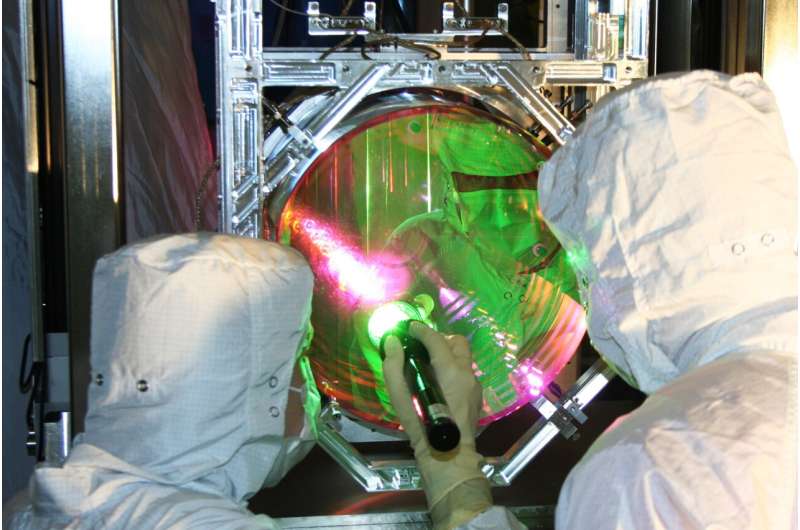This article has been reviewed according to Science X's editorial process and policies. Editors have highlighted the following attributes while ensuring the content's credibility:
fact-checked
peer-reviewed publication
trusted source
proofread
Experiment could test quantum nature of large masses for the first time

An experiment outlined by a UCL (University College London)-led team of scientists from the UK and India could test whether relatively large masses have a quantum nature, resolving the question of whether quantum mechanical description works at a much larger scale than that of particles and atoms.
Quantum theory is typically seen as describing nature at the tiniest scales, and quantum effects have not been observed in a laboratory for objects more massive than about a quintillionth of a gram, or more precisely 10-20g.
The new experiment, described in a paper published in Physical Review Letters and involving researchers at UCL, the University of Southampton, and the Bose Institute in Kolkata, India, could, in principle, test the quantumness of an object regardless of its mass or energy.
The proposed experiment exploits the principle in quantum mechanics that the act of measurement of an object can change its nature. (The term measurement encompasses any interaction of the object with a probe—for instance if light shines on it or if it emits light or heat).
The experiment focuses on a pendulum-like object oscillating like a ball on a string. A light is shone on one-half of the area of oscillation, revealing information about the location of the object (i.e., if scattered light is not observed, then it can be concluded that the object is not in that half). A second light is shone, showing the location of the object further along on its swing.
If the object is quantum, the first measurement (the first flash of light) will disturb its path (by measurement-induced collapse—a property inherent to quantum mechanics), changing the likelihood of where it will be at the second flash of light, whereas if it is classical, then the act of observation will make no difference. Researchers can then compare scenarios in which they shine a light twice to ones where only the second flash of light occurs to see if there is a difference in the final distributions of the object.
Lead author Dr. Debarshi Das (UCL Physics & Astronomy and the Royal Society) said, "A crowd at a football match cannot affect the result of the game simply by staring strongly. But with quantum mechanics, the act of observation or measurement itself changes the system."
"Our proposed experiment can test if an object is classical or quantum by seeing if an act of observation can lead to a change in its motion."
The proposal, the researchers say, could be implemented with current technologies using nanocrystals or, in principle, even using mirrors at LIGO (Laser Interferometer Gravitational-Wave Observatory) in the United States which have an effective mass of 10kg.
The four LIGO mirrors, which each weigh 40kg but together vibrate as if they were a single 10kg object, have already been cooled to the minimum-energy state (a fraction above absolute zero) that would be required in any experiment seeking to detect quantum behavior.
Senior author Professor Sougato Bose (UCL Physics & Astronomy) said, "Our scheme has wide conceptual implications. It could test whether relatively large objects have definite properties, i.e., their properties are real, even when we are not measuring them. It could extend the domain of quantum mechanics and probe whether this fundamental theory of nature is valid only at certain scales or if it holds true for larger masses, too.
"If we do not encounter a mass limit to quantum mechanics, this makes ever more acute the problem of trying to reconcile quantum theory with reality as we experience it."
In quantum mechanics, objects do not have definite properties until they are observed or interact with their environment. Prior to observation they do not exist in a definite location but may be in two places at once (a state of superposition). This led to Einstein's remark: "Is the moon there when no one is looking at it?"
Quantum mechanics may seem at odds with our experience of reality, but its insights have helped the development of computers, smartphones, broadband, GPS, and magnetic resonance imaging.
Most physicists believe quantum mechanics holds true at larger scales but is merely harder to observe due to the isolation required to preserve a quantum state. To detect quantum behavior in an object, its temperature or vibrations must be reduced to its lowest possible level (its ground state), and it must be in a vacuum so that nearly no atoms are interacting with it. That is because a quantum state will collapse, a process called decoherence if the object interacts with its environment.
The new proposed experiment is a development of an earlier quantum test devised by Professor Bose and colleagues in 2018. A project to conduct an experiment using this methodology, which will test the quantum nature of a nanocrystal numbering a billion atoms, is already underway, led by the University of Southampton.
That project already aims for a jump in terms of mass, with previous attempts to test the quantum nature of a macroscopic object limited to hundreds of thousands of atoms. The newly published scheme, meanwhile, could be achieved with current technologies using a nanocrystal with trillions of atoms.
More information: Debarshi Das et al, Mass-Independent Scheme to Test the Quantumness of a Massive Object, Physical Review Letters (2024). DOI: 10.1103/PhysRevLett.132.030202
Journal information: Physical Review Letters
Provided by University College London





















